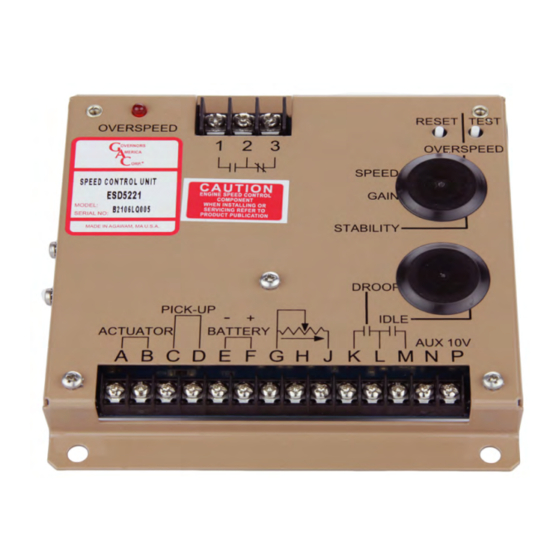GAC ESD-5550 Series Manual - Page 8
Browse online or download pdf Manual for Control Unit GAC ESD-5550 Series. GAC ESD-5550 Series 8 pages. Speed control unit
Also for GAC ESD-5550 Series: Technical Information (12 pages), Manual (8 pages)

7
SySTEM TROUblESHOOTINg (CONTINUED)
InSTaBILITY
InSTaBILITY
SYmPTom
Fast Periodic
The engine seems
to jitter with a 3Hz
or faster irregularity
of speed.
Slow Periodic
An irregularity
of speed below
3Hz. (Sometimes
severe)
Non-Periodic
Erratic Engine
Behavior
UnSaTISfacTorY Performance
SYmPTom
Engine Overspeeds
1.
2.
Overspeed Shuts Down En-
gine After Running Speed is
Reached
Overspeed Shuts Down En-
gine Before Running Speed
is Reached
Actuator does not energize
1.
fully
2.
Engine remains below
1.
desired governed speed
1.
Readjust the GAIN and STABILITy for optimum control.
2.
Turn off any local electrical equipment that may be causing EMI interference.
3.
Set the Lead Circuit DIP switch SW1 to OFF
4.
If system is still unstable, set Soft Coupling SW2 to ON. This may indicate soft or worn couplings in drive
train.
5.
Remove E1 to E2 jumper. See section 4, Wiring diagram.
1.
Readjust GAIN and STABILITy
2.
Set Lead Circuit and Soft Coupling DIP switches SW1 and SW2 to ON in the following order: First SW1,
Second SW2, and Third SW1 & SW2.
3.
Check fuel system linkage during engine operation for:
•
binding
•
high friction
•
poor linkage
4.
Adjust DEAD TIME COMPENSATION by adding a capacitor from posts E1 to E2. See section 4, Wiring
diagram. Start with 10 mF and increase until instability is eliminated.
5.
Add small amount of droop (jumper K and L). See section 4, Wiring diagram.
1.
If increasing GAIN does not reduce the instability but not totally correct it issue may be with engine.
2.
If this is the case, there is most likely a problem with the engine itself. Check for:
•
engine mis-firings
•
an erratic fuel system
•
load changes on the generator set voltage regulator.
3.
If throttle is slightly erratic, but performance is fast, move SW1 to the OFF position.
normaL reaDInG
Do Not Crank. Apply DC power to
the governor system.
Manually hold the engine at the
desired running speed. Measure
the DC voltage between Terminals
A(-) & F(+) on the speed control
unit.
Check impedance between
Terminals C & D. Should be 160
to 1200 Ω
Measure the voltage at the battery
while cranking.
Momentarily connect Terminals A
and F. The actuator should move
to the full fuel position.
Measure the actuator output, Ter-
minals A & B, while running under
governor control.
ProBaBLe SoLUTIon
ProBaBLe caUSe
After the actuator goes to full fuel, disconnect the speed sensor at Terminal
C & D. If the actuator is still at full fuel-speed then the speed control unit is
defective.
1.
If the voltage reading is 1.0 to 2.0 V DC:
•
SPEED adjustment is set above desired speed
•
Defective speed control unit
2.
If voltage reading is above 2.0 V DC then check for:
•
actuator binding
•
linkage binding
3.
If the voltage reading is below 1.0 V DC it may be a defective speed
control unit
4.
Check if Gain is set too low.
•
Speed adjustment set too high.
•
OVERSPEED set to close to running speed.
•
Actuator or linkage binding.
•
Speed control unit defective.
OVERSPEED set too low. Adjust 5-6 turns CW.
Erroneous speed sensor signal. Check wiring.
If voltage for a 12 V DC system is less than 7 V DC, or for a 24 V DC system is
less than 14 V DC, replace the battery if weak or undersized
•
Actuator or battery wiring in error
•
Actuator or linkage binding
•
Defective actuator
•
Fuse opens. Check for short in actuator or harness.
If voltage measurement is within 2 V DC of the battery supply voltage level,
then fuel control is restricted from reaching full fuel position, possibly due to
mechanical governor, carburetor spring, or linkage interference.
SPEED parameter set too low
8
ESD5550-5570 Series Speed Control Unit 9-2020-E PIB1003
Governors America Corp. © 2020 Copyright All Rights Reserved
